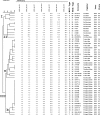Epidemiology of a Salmonella enterica subsp. enterica serovar Typhimurium strain associated with a songbird outbreak
- PMID: 22885752
- PMCID: PMC3457103
- DOI: 10.1128/AEM.01408-12
Epidemiology of a Salmonella enterica subsp. enterica serovar Typhimurium strain associated with a songbird outbreak
Abstract
Salmonella enterica subsp. enterica serovar Typhimurium is responsible for the majority of salmonellosis cases worldwide. This Salmonella serovar is also responsible for die-offs in songbird populations. In 2009, there was an S. Typhimurium epizootic reported in pine siskins in the eastern United States. At the time, there was also a human outbreak with this serovar that was associated with contaminated peanuts. As peanuts are also used in wild-bird food, it was hypothesized that the pine siskin epizootic was related to this human outbreak. A comparison of songbird and human S. Typhimurium pulsed-field gel electrophoresis (PFGE) patterns revealed that the epizootic was attributed not to the peanut-associated strain but, rather, to a songbird strain first characterized from an American goldfinch in 1998. This same S. Typhimurium strain (PFGE type A3) was also identified in the PulseNet USA database, accounting for 137 of 77,941 total S. Typhimurium PFGE entries. A second molecular typing method, multiple-locus variable-number tandem-repeat analysis (MLVA), confirmed that the same strain was responsible for the pine siskin epizootic in the eastern United States but was distinct from a genetically related strain isolated from pine siskins in Minnesota. The pine siskin A3 strain was first encountered in May 2008 in an American goldfinch and later in a northern cardinal at the start of the pine siskin epizootic. MLVA also confirmed the clonal nature of S. Typhimurium in songbirds and established that the pine siskin epizootic strain was unique to the finch family. For 2009, the distribution of PFGE type A3 in passerines and humans mirrored the highest population density of pine siskins for the East Coast.
Figures




Similar articles
-
Pulsed-field gel electrophoresis supports the presence of host-adapted Salmonella enterica subsp. enterica serovar Typhimurium strains in the British garden bird population.Appl Environ Microbiol. 2011 Nov;77(22):8139-44. doi: 10.1128/AEM.00131-11. Epub 2011 Sep 23. Appl Environ Microbiol. 2011. PMID: 21948838 Free PMC article.
-
Pork contaminated with Salmonella enterica serovar 4,[5],12:i:-, an emerging health risk for humans.Appl Environ Microbiol. 2010 Jul;76(14):4601-10. doi: 10.1128/AEM.02991-09. Epub 2010 May 14. Appl Environ Microbiol. 2010. PMID: 20472721 Free PMC article.
-
Simultaneous analysis of multiple enzymes increases accuracy of pulsed-field gel electrophoresis in assigning genetic relationships among homogeneous Salmonella strains.J Clin Microbiol. 2011 Jan;49(1):85-94. doi: 10.1128/JCM.00120-10. Epub 2010 Oct 27. J Clin Microbiol. 2011. PMID: 20980570 Free PMC article.
-
Genome Variation and Molecular Epidemiology of Salmonella enterica Serovar Typhimurium Pathovariants.Infect Immun. 2018 Jul 23;86(8):e00079-18. doi: 10.1128/IAI.00079-18. Print 2018 Aug. Infect Immun. 2018. PMID: 29784861 Free PMC article. Review.
-
Outbreak of monophasic Salmonella Typhimurium Sequence Type 34 linked to chocolate products.Ann Med Surg (Lond). 2022 Sep 8;82:104597. doi: 10.1016/j.amsu.2022.104597. eCollection 2022 Oct. Ann Med Surg (Lond). 2022. PMID: 36268287 Free PMC article. Review.
Cited by
-
Antibiotic Resistance in Salmonella enterica Serovar Typhimurium Associates with CRISPR Sequence Type.Antimicrob Agents Chemother. 2013 Sep;57(9):4282-4289. doi: 10.1128/AAC.00913-13. Epub 2013 Jun 24. Antimicrob Agents Chemother. 2013. PMID: 23796925 Free PMC article.
-
Human Salmonellosis Outbreak Linked to Salmonella Typhimurium Epidemic in Wild Songbirds, United States, 2020-2021.Emerg Infect Dis. 2023 Nov;29(11):2298-2306. doi: 10.3201/eid2911.230332. Emerg Infect Dis. 2023. PMID: 37877570 Free PMC article.
-
Whole-Genome Subtyping Reveals Population Structure and Host Adaptation of Salmonella Typhimurium from Wild Birds.J Clin Microbiol. 2023 Jun 20;61(6):e0184722. doi: 10.1128/jcm.01847-22. Epub 2023 May 30. J Clin Microbiol. 2023. PMID: 37249426 Free PMC article.
-
Antimicrobial Resistant Salmonella in Chelonians: Assessing Its Potential Risk in Zoological Institutions in Spain.Vet Sci. 2022 May 31;9(6):264. doi: 10.3390/vetsci9060264. Vet Sci. 2022. PMID: 35737316 Free PMC article.
-
Characterization of Salmonella enterica serovar Typhimurium and Salmonella enterica serovar 4,[5],12:i:- isolates from pigs presenting with diarrhea in Korea.J Vet Med Sci. 2015 Nov;77(11):1511-5. doi: 10.1292/jvms.15-0151. Epub 2015 Jun 14. J Vet Med Sci. 2015. PMID: 26074410 Free PMC article.
References
-
- Alley MR, et al. 2002. An epidemic of salmonellosis caused by Salmonella Typhimurium DT160 in wild birds and humans in New Zealand. N. Z. Vet. J. 50:170–176 - PubMed
-
- . 2007. Laboratory standard operating procedure for analysis of MLVA data of Salmonella enterica serotype Typhimurium in BioNumerics—Beckman Coulter 8000 data. http://www.pulsenetinternational.org/SiteCollectionDocuments/mlva/PND15_...
-
- Anonymous 2007. Laboratory standard operating procedure for PulseNet MLVA of Salmonella enterica serotype Typhimurium—Beckman Coulter CEQ 8000 platform. http://www.pulsenetinternational.org/SiteCollectionDocuments/mlva/PNL21_...
-
- Anonymous 2009. 2009 results: map of Pine Siskin. The Great Backyard Bird Count. http://gbbc.birdsource.org/gbbcApps/maproom?cmd=OneMapDisplay&sppOrder=a...
-
- Anonymous 2011. Vital signs: incidence and trends of infection with pathogens transmitted commonly through food—Foodborne Diseases Active Surveillance Network, 10 U.S. sites, 1996-2010. MMWR Morb. Mortal. Wkly. Rep. 60:749–755 - PubMed
Publication types
MeSH terms
Substances
Grants and funding
LinkOut - more resources
Full Text Sources
Research Materials

